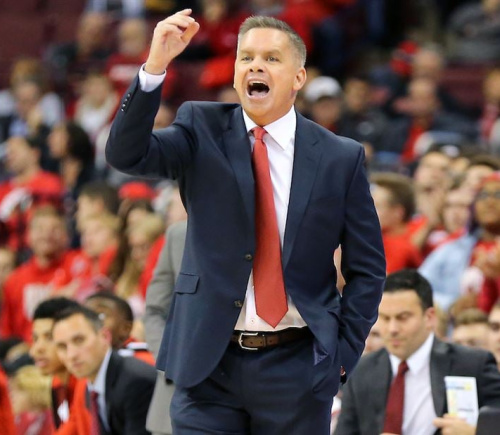Chris Holtmann’s promising start over the early portions of his career in Columbus didn’t bring the sustained success required to keep him on the OSU sideline.
Patience ran out on Chris Holtmann before his seventh season could conclude, because this year looked too much like last year, and every loss began looking like the one that came before.
 Columbus, OH – Chris Holtmann’s firing as Ohio State’s head basketball coach with six games left in the regular season came at the right time for the right reasons on Wednesday, some 15 hours after OSU’s 16th straight road defeat and ninth loss in 11 games.
Columbus, OH – Chris Holtmann’s firing as Ohio State’s head basketball coach with six games left in the regular season came at the right time for the right reasons on Wednesday, some 15 hours after OSU’s 16th straight road defeat and ninth loss in 11 games.
There was nothing distinctive about the 62-54 loss at Wisconsin on Tuesday night.
If anything, the unacceptable aspect was that it featured the same issues which have befallen Holtmann’s teams the past two seasons – issues he’s shown no capacity to correct.

Want a greener, healthier lawn? We can help. contact Weedman USA at 614-733-3747 or go online to Weedman.com.
A collective lack of energy at the outset, an inability of any player to steady the struggling Buckeyes with a big rebound or clutch basket when needed, a propensity for the offense to enter the Witness Protection Program at the most inopportune time…if you’ve seen one OSU loss the last two Big Ten seasons, you’ve seen them all.
Every bit of that is on Holtmann, but he doesn’t wear it alone.
There’s someone right there beside him in the Fitting Room of Failure, cloaked in his own responsibility for the colossal collapse of this program that is capable of considerably more that it’s delivered.
This will be OSU’s second straight season without making the NCAA Tournament and its seventh year in a row without reaching the Sweet Sixteen.
Thad Matta, fired after two such NCAA-less seasons at the end of his 13-year stint with the Buckeyes, got to the NCAA title game in his third year, reached consecutive Sweet 16s, another Final Four and the Elite Eight in succession and won five Big Ten championships and four league tournament titles.
The guy who fired Matta is the same guy who hired and now fired Holtmann…OSU’s lame-duck athletic director, Gene Smith, and it is Smith who is the additional accomplice to this disastrous meltdown of the Ohio State’s basketball program.
Smith isn’t guilty because he hired Holtmann, nor because Smith stupidly gave Holtmann a contract extension three years ago when there was no reason to do so.
Remember, Holtmann’s original deal still had two years to run when he, his agent or Smith’s own ineptitude and inability to read the college basketball landscape convinced the OSU AD to enrich and extend the coach’s deal.
The new terms still have four years remaining after this one, which is why OSU will pay Holtmann $12.5 million to go away in advance of a 1 p.m. Sunday tip against No. 2 Purdue at Value City Arena.

Many fans remember how St. John Arena once rocked during OSU’s golden era, but they forget that Value City Arena also pulsated when the Buckeyes were consistently a Top Ten program, which they haven’t been for some time.
That game will be nationally-televised on CBS, and you can bet the prospect of students showing up with paper bags over their heads or disgruntled fans chanting, “Fire Holtmann,” wasn’t something the Buckeyes’ brass wanted broadcast coast-to-coast.
Already, after home losses to Indiana – which overcame an 18-point, second-half deficit – and Illinois have prompted such catcalls in the tomb that passes as OSU’s arena because Holtmann and Smith have tag-teamed interest in the program into submission.
The reason Smith bears considerable responsibility for turning the Buckeyes into a Big Ten laughingstock is because he encouraged Holtmann to double-down on the plan for building OSU’s roster that clearly wasn’t working.
Listen to Holtmann less than one year ago after blunting a losing streak with a Feb. 23 home win over Illinois.
“Gene and I have been very open about our plan in terms of moving forward and what our plan was after last year with somewhat of a rebuilt roster, what that was going to look like,” Holtmann said. “How young we were going to be?. Our commitment to playing young guys, to backing it up with another young class.
“It’s a little bit hard to do sometimes when you’re going into Year Six and you’re saying, ‘OK, we’re going to philosophically look at how we want to build this thing to give us maybe our greatest potential as a program.’
“But I think we have played our young guys. We have another good class coming. There is some real excitement in that amid the tremendous disappointment with how things have gone.”

The Dave Arbogast family of dealerships proudly sponsors Ohio State sports coverage on Press Pros Magazine.
That old-fashioned strategy can work if the freshmen recruits enter OSU with the immediate-impact potential of a Malaki Branham or a Brice Sensabaugh.
The trouble with this team is, none of OSU’s sophomores are sure-fire NBA players. Not Bruce Thornton, as good as he sometimes is, nor Roddy Gayle, not Felix Okpara nor Bowen Hardman.
And, the freshman class Holtmann and Smith placed so much confidence in is collectively worse.
Devin Royal is a tweener, not fast enough to play the wing, not powerful enough (yet) to defend in the low post.

Chris Holtmann reaction to his team’s offensive struggles became an all-too-familiar site over the past two seasons.
Taison Chatman and Austin Parks haven’t made a single basket all year. Parks may develop in time. Chatman, the highest-rated of the bunch coming in, got injured early and has been a non-factor.
Scotty Middleton has contributed more than any other freshman, but he averages only 3.7 points per-game, has been both suspended for a game and injured, and clearly lacks the explosiveness or speed to offset his clear deficiencies in strength.
Only Royal and Parks look even remotely like they could develop physically into serviceable Big Ten players down the road, which is entirely on Holtmann to recognize while he’s recruiting.
This is not a recent phenomenon either. Ask yourself, did Eugene Brown, Musa Jallow, Zed Key, Kalen Etzler, Ibrahima Diallo or Alonzo Gaffney ever scream, Lottery Pick, to you?
Such misfires can be fixed, or mitigated, in this age of the immediate-eligibility transfer, but Holtmann’s transfers over the last four seasons have mostly been egregiously average at best.
Jamison Battle, who averages 13.7 points, has made an impact this year compared to the middling talent around him on the Ohio State roster. But Battle is not Marcus Domask from Illinois, A.J. Storr from Wisconsin, Lance Jones from Purdue or Rienk Mast from Nebraska.
Not coincidentally, all four of those teams are virtual NCAA Tournament locks.
Battle is the first transfer in the four years players could hop from one school to another and play immediately to average more than 10 points per-game for the Buckeyes.
He’s only the fourth of 12 Holtmann transfers to start more than half of the Buckeyes’ games in his first season. Another is Evan Mahaffey, who’s started every game this year after averaging three points and two rebounds last season at Penn State.
Mahaffey is a role player, not an impact player, as were far too many Holtmann transfers before him.
Try not to recall their names — Seth Towns, Isaac Likekele, Jimmy Sotos, Joey Brunk — it’s not worth the migraine.
In hindsight, Holtmann’s inability to know what an elite Big Ten player looks like was evident when he took the job in the summer of 2017.
He waxed at length then about his emotional tug-of-war over leaving Butler, fawning over a clearly-inferior job where he would never have a chance to win the national championship that was well within his reach, given the resources at OSU.
The longer Holtmann went down that road, the more his comments began to expose an annoying, think-small mentality that suggested he would never embrace the expectations he well knew came with the job he had just accepted.
Therein was the evidence that Holtmann would struggle to maximize the potential inherent in being the coach at Ohio State.
Turns out, while Holtmann’s body came to Columbus, his mind remained mired in the mid-major mindset from which he came.




